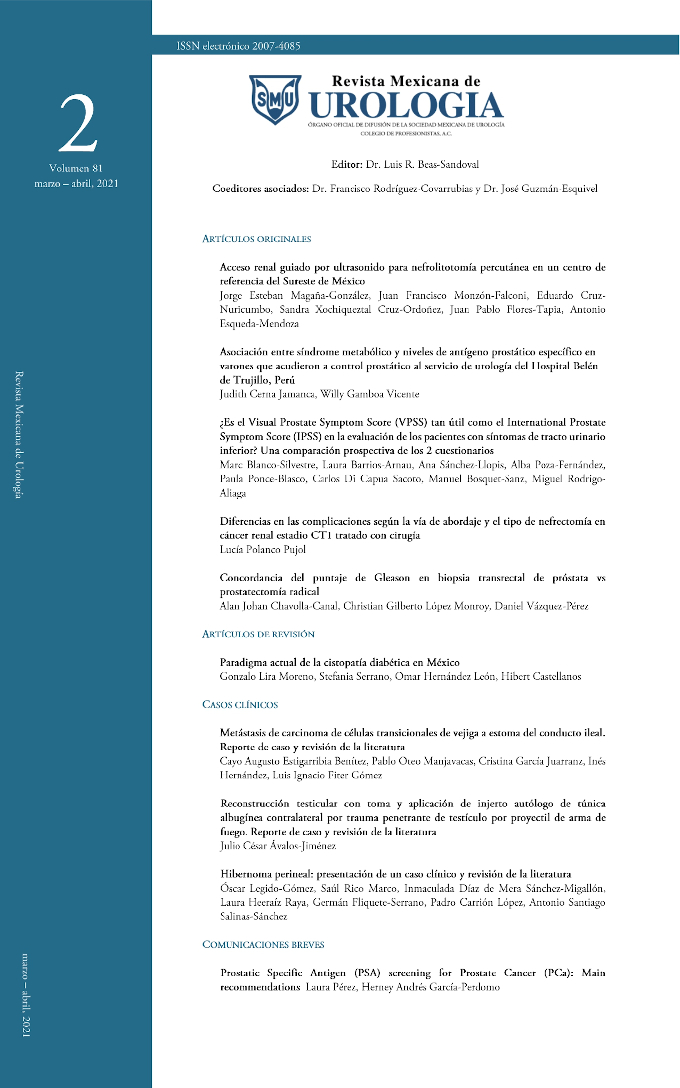Ultrasound-guided renal access for percutaneous nephrolithotomy at a referral center in Southeast Mexico
DOI:
https://doi.org/10.48193/revistamexicanadeurologa.v81i2.750Keywords:
Percutaneous nephrolithotomy (PCNL), renal access, ultrasound, Guy scale.Abstract
ABSTRACT Percutaneous nephrolithotomy (PCNL) is the treatment of choice for staghorn stones and large kidney stones (greater than 2 cm). Percutaneous renal access can be achieved either guided by ultrasound or fluoroscopy. The method of choice depends on training and personal preferences. Ultrasound has several strengths as an interventional tool and offers several advantages over fluoroscopy: it is readily available, portable, relatively inexpensive as well as reduced radiation exposure. While there is a learning curve to mastering these techniques, their adoption can lead to less radiation exposure for patients, urologists, and ancillary healthcare providers when performing percutaneous nephrolithotomy. Goals Describe the surgical technique, as well as the clinical characteristics of the patients undergoing Percutaneous Nephrolithotomy with renal access guided by USG at the Hospital Regional De Alta Especialidad de la Peninsula de Yucatán in the period January 2019 to January 2021. Material and methods An observational, retrospective, descriptive study was carried out of the clinical records of a total of 22 patients with a diagnosis of renal lithiasis corroborated by a tomography study, who underwent PCNL with ultrasound-guided puncture. Results A total of 22 PCNL with ultrasound-guided renal access were performed in a period of one year (January 2019 to January 2020). 72.7% of the patients were female and 27.3% male. 50% (11) had obesity. 68.2% (15) belonged to the ASA 2 anesthetic risk classification, 22.7% (5) ASA 3 and 9.1% (2) ASA 1. Within the characteristics of the stone according to the GUY Stone Score classification, the 40.9% (9) had a GUY III and 27.3% (6) had a GUY IV. Among the surgical characteristics: the tract was performed in 45.5% by an endourology fellow in (10) 22.7%, (5) by R5, 9.1% (2) by R4 and 22.7% by an endourology physician. Regarding the number of punctures, 45.5% (10) only required one puncture. 5 patients 2 punctures, 5 patients 3 punctures, 1 patient 4 punctures and 1 patient plus 5 punctures; In 95.5% (21) the tract was successful, only in one patient the tract was failed. The puncture was performed in the Valdivia / Galdakao position in 90.0% (20) and in the prone position in 9.1% (2). The number of tracts performed was unitract in 95.5% (21). Conclusions Ultrasound-guided access for percutaneous nephrolithotomy (PCNL) is a safe, effective, radiation-free and low-cost technique that can be used in any hospital. This technique requires structured training which must start from the residence.Downloads
Published
2021-05-16
Issue
Section
Original articles






